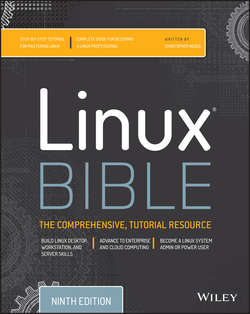Читать книгу Linux Bible - Christopher Negus - Страница 9
На сайте Литреса книга снята с продажи.
Part I
Getting Started
Chapter 2
Creating the Perfect Linux Desktop
ОглавлениеUsing Linux as your everyday desktop system is becoming easier to do all the time. As with everything in Linux, you have choices. There are full-featured GNOME or KDE desktop environments or lightweight desktops such as LXDE or Xfce. There are even simpler standalone window managers.
After you have chosen a desktop, you will find that almost every major type of desktop application you have on a Windows or Mac system has equivalent applications in Linux. For applications that are not available in Linux, you can often run a Windows application in Linux using Windows compatibility software.
The goal of this chapter is to familiarize you with the concepts related to Linux desktop systems and to give you tips for working with a Linux desktop. In this chapter you:
● Step through the desktop features and technologies that are available in Linux
● Tour the major features of the GNOME desktop environment
● Learn tips and tricks for getting the most out of your GNOME desktop experience
To use the descriptions in this chapter, I recommend you have a Fedora system running in front of you. You can get Fedora in lots of ways, including these:
● Running Fedora from a live medium– Refer to Appendix A for information on downloading and burning Fedora Live image to a DVD or USB drive so you can boot it live to use with this chapter.
● Installing Fedora permanently– Install Fedora to your hard disk and boot it from there (as described in Chapter 9, “Installing Linux”).
Because the current release of Fedora uses the GNOME 3 interface, most of the procedures described here work with other Linux distributions that have GNOME 3 available. If you are using an older Red Hat Enterprise Linux system (RHEL 6 uses GNOME 2, but RHEL 7 uses GNOME 3), I added descriptions of GNOME 2 that you can try as well.
NOTE
Ubuntu uses its own Unity desktop as its default, instead of GNOME. There is, however, an Ubuntu GNOME project. To download the medium for the latest Ubuntu version with a GNOME desktop, go to the Ubuntu GNOME download page (http://ubuntugnome.org/download/).
You can add GNOME and use it as the desktop environment for Ubuntu 11.10 and later. Older Ubuntu releases use GNOME 2 by default.
